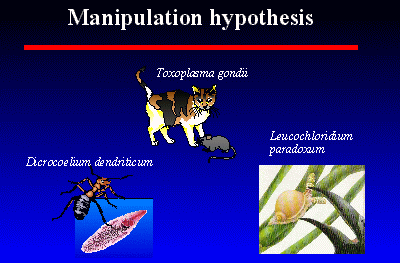Manipulation hypothesis


In early 90€th€ we started to study the so-called manipulation hypothesis. It posits that many species of parasites influence the phenotype, and mostly the behavior, of their hosts. The specific changes induced by the parasites increase the probability of the parasite’s transmission to the next host. Classical example of a parasite- manipulator is a fluke Dicrocelium dendriticum. This fluke needs to get from its intermediate host, an ant, into a definitive host, cattle or sheep. It is not an easy task as ruminants usually don’t eat ants. However, the fluke is able to enter a subesophageal ganglion of the ant and reprogram there somehow the behavior of its host. When the temperature drops in the evening, infected ants climb to the tops of grass blades and grasp them firmly in their mandibles. They remain attached until later the next day when they warm up and seemingly resume normal behavior. This behavioral pattern keeps the infected ants near the tops of vegetation in the active periods of grazing by ruminants in the evening and morning hours. Another fluke, Leucochloridium paradoxum, infects land snails as its first intermediate hosts and insectivorous birds as definitive hosts. The sporocysts of the fluke move into the snail’s tentacles and pulsate, looking to all the world, and especially to the birds like caterpillars.


